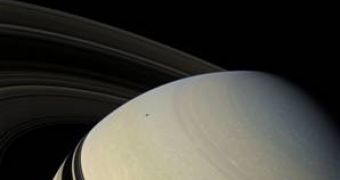Exactly four years ago the Cassini-Huygens mission reached the Saturnian system and entered orbit around the ringed planet, in order to make a series of observations that would astonish the world. It is probably one of the most successful robotic missions to one of the gas giants conducted by NASA and the ESA and was concluded yesterday, as the US space agency stated that the spacecraft had accomplished its primary objective and would embark on a two-year extended mission that would have the main role of studying the moons of Saturn.
At the end of the two-year extension, the Cassini mission may again be prolonged if and only if the spacecraft is in the condition to further continue research.
The Cassini spacecraft is owned by NASA while the Huygens probe, deployed in early 2005 to the surface of Saturn's biggest moon, Titan, was built by ESA. Huygens' observations revealed that Titan's surface was covered with hydrocarbon seas and channels, while Cassini showed that Enceladus presented ice geysers that could be evidence that it housed a water ocean beneath its icy surface, again sparking the possibility of life on another celestial body except Earth.
Although Saturn holds more than sixty moons of various sizes, Titan and Enceladus are still the most complex and interesting of all, which can be easily seen in NASA's objectives that set these two moons as primary targets for study during the two-year extended assignment. Alternatively, Cassini will continue studying the magnetic field of Saturn and will position itself to observe one of the rarest events that occur in the solar system, Saturn's equinox, which takes place every 15 years.
During the equinox, the rings of the planet will be edge on to the Sun and given the rarity and the importance of the upcoming observation, expected to occur on August 11, 2009, NASA decided to name the operation the 'Cassini Equinox Mission'.
The original mission drew 3.3 billion dollars out of both NASA's and ESA's pockets, but the full bill of the Cassini extended undertaking will fall on NASA alone this time.
"We've had a wonderful mission and a very eventful one in terms of the scientific discoveries we've made, and yet an uneventful one when it comes to the spacecraft behaving so well. We are incredibly proud to have completed all of the objectives we set out to accomplish when we launched. We answered old questions and raised quite a few new ones, and so our journey continues," said Bob Mitchell, Cassini program manager at NASA's Jet Propulsion Laboratory.
A new beginning for a mission doesn't always require a new project scientist, however in the case of Cassini it's going to happen anyway since the project scientist for the primary mission Dennis Matson appears to have chosen to focus his work on future flagship space missions and will be replaced by geologist Bob Pappalardo.
"To explore a planetary system very much unlike our own is an occasion like no other. It has been hard going and exhausting for sure, but in return we have been rewarded beyond all imagining. Without equivocation, we on Cassini can proudly proclaim: Mission accomplished!" concluded Carolyn Porco of the Colorado Space Science Institute and leader of the Cassini imaging team.

 14 DAY TRIAL //
14 DAY TRIAL //